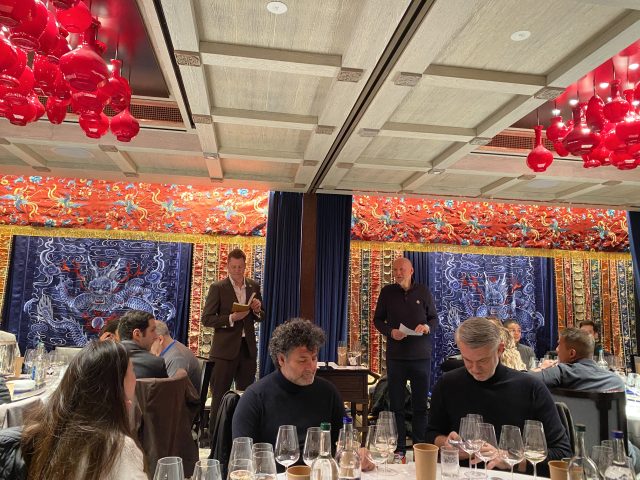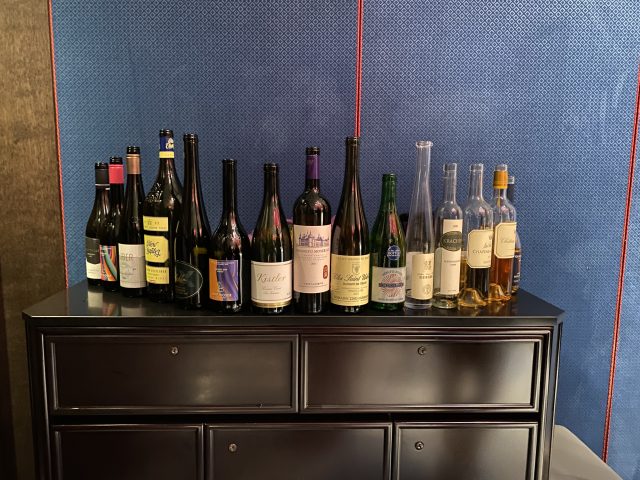This website uses cookies so that we can provide you with the best user experience possible. Cookie information is stored in your browser and performs functions such as recognising you when you return to our website and helping our team to understand which sections of the website you find most interesting and useful.
Lenz Moser: ‘don’t miss the boat on a white wine boom in China’
Showcasing Chinese wines alongside a lineup of global benchmarks at a tasting this week, fifth-generation Austrian winemaker Lenz Moser V says whites are China’s next big hit. Eloise Feilden reports.

“When the Germans and the Austrians were still climbing trees, the Chinese were developing culture,” Moser said to a room of Masters of Wine, journalists and sommeliers on Tuesday (19 March).
The Changyu Moser XV winemaker stood alongside Master Sommelier and fellow Austrian Stefan Neumann for the inaugural London Tasting, a blind comparison of dry white and sweet wines showing some of global ‘benchmarks’ against lesser-known wines and regions.
Inspired by Spurrier’s 1976 Judgement of Paris, Moser held his own Paris Tasting in February, showing Changyu Moser XV wines alongside the likes of Cloudy Bay, Opus One, Lafite, Sassicaia and Chablis Premier Cru Fevre.
The wines, immediately recognised by the judges as distinctly Chinese, held up well against the global icons which set the benchmark for quality.
In London this week at the Peninsula hotel, Moser and Neumann also presented some of the winemaker’s global projects against iconic names including d’Yquem, Sonoma’s Kistler and Wachau’s F.X. Pichler.
“The stars are the wines,” Moser said. His objective? To bring lesser-known regions into a conversation with those considered the best in the world. “One of my mottos is simple – life doesn’t happen by itself, you have to make it happen,” he said.
Dry white wines were the star of the show, followed by two flights of sweet wines. “I believe white winemaking is much more difficult than red winemaking,” he said, somewhat controversially.
The latest vintage of Changyu Moser XV’s only white wine, 2021 Cabernet Sauvignon ‘Blanc de Noir’ (the only white Cabernet Sauvignon in the world), featured in the tasting.
In 2021, red wine’s share of Chinese wine production stood at 86.3%, according to OIV figures. As it stands, China’s wine consumption is also mostly about red wine; with a share of 92% in 2021, it is the country that consumes most red wine, at least in relative terms. This share has been consistently increasing since the year 2000, when it was 81%, at the expense of white and rosé wines, which in 2021 account for 7% and 1% respectively.
However, Moser is putting his hopes in China’s ability to produce (and consume) quality whites. “We don’t want to miss the boat on the white wine boom in China,” he warned.
This comes with its fair share of challenges. When searching for new vineyards for Changyu in 2015, Moser was looking for plots to make white wines, but couldn’t find any. As a solution, he began making white wine using free-run juice from Cabernet Sauvignon berries in Ningxia — a process which is “relatively expensive” considering how many grapes are needed for even small quantities of colourless free-run liquid.

Now he says his Chinese Chateau is on the way to producing more white wines, exploring new varieties to do so.
“The only thing I can promise from China is that with each vintage, quality is getting better,” he said this week.
Quality and value were the focus in terms of comparison at the London Tasting, rather than style. “We picked what we like the most,” he said in response to a question about the through-line of the tasting.
Six sweet wines were also shown, as a bid to “break the stigma” with the category which is being consumed less and less.
An ice wine from Changyu, made in the Lianoning region of China, was shown blind in a flight also comprising a Château de Fargues Sauternes and Kracher Beerenauslese Cuvee from Austria.
According to Moser, Chinese wine’s producers brought 340ha of Vidal to China, producing ice wine at three quality levels, as a means of competing on the global stage when it comes to fine wine — an objective certainly spurred on by tastings like this, which list Chinese wines side by side with the likes of iconic names including Yquem.
The full list of wines includes:
- 2022 Assyrtiko, Vassaltis, Santorini, Greece 14% ABV (tasted blind)
- 2021 Furmint, MM5, Ma’d Moser, Tokaj, Hungary 14% ABV (tasted blind)
- 2022 Gruener Veltliner, New Chapter, Niederösterreich, Austria – from Magnum 13% ABV
- 2022 Grüner Veltliner Ried Zwirch, Markus Huber, Traisental, Austria 13% ABV
- 2022 Grüner Veltliner Kellerberg, F.X. Pichler, Wachau, Austria 13.5% ABV
- 2021 Furmint, MM55, Ma’d Moser, Tokaj, Hungary 14% ABV
- 2021 Chardonnay Les Noisetiers, Kistler, Sonoma Coast, USA 14.3% ABV (tasted blind)
- 2021 Cabernet Sauvignon ‘Blanc de Noir’, Helan Mountain Range, Ningxia, China 14.5% ABV
- 2021 Pinot Gris, Clos Saint Urbain, Rangen de Thann, Zind Humbrecht, Alsace, FR 13.5% ABV
- 2022 Arinto, Ribeiro & Moser, Vinho Regional Lisboa, Portugal 12.5% ABV
- 2021 Vidal, Ice Wine, Changyu, Lianoning, China 11%ABV (tasted blind)
- 2015 Château de Fargues, Lur Saluces, Sauternes, France 14%ABV (tasted blind)
- 2020 Beerenauslese Cuvee, Kracher, Burgenland, Austria 11% ABV (tasted blind)
- 2016 Château d’Yquem, Sauternes France 14% ABV (tasted blind)
- 2013 Tokaji Aszu 6 puttonyos MM 555, Mad Moser x Grand Tokaj Hungary 9,5% ABV (tasted blind)
- 2019Tokaji Aszu 6 puttonyos, Füleky, Tokaj, Hungary 10% ABV (tasted blind)

